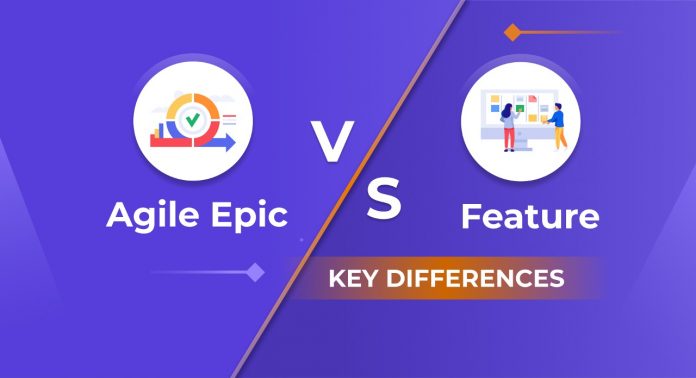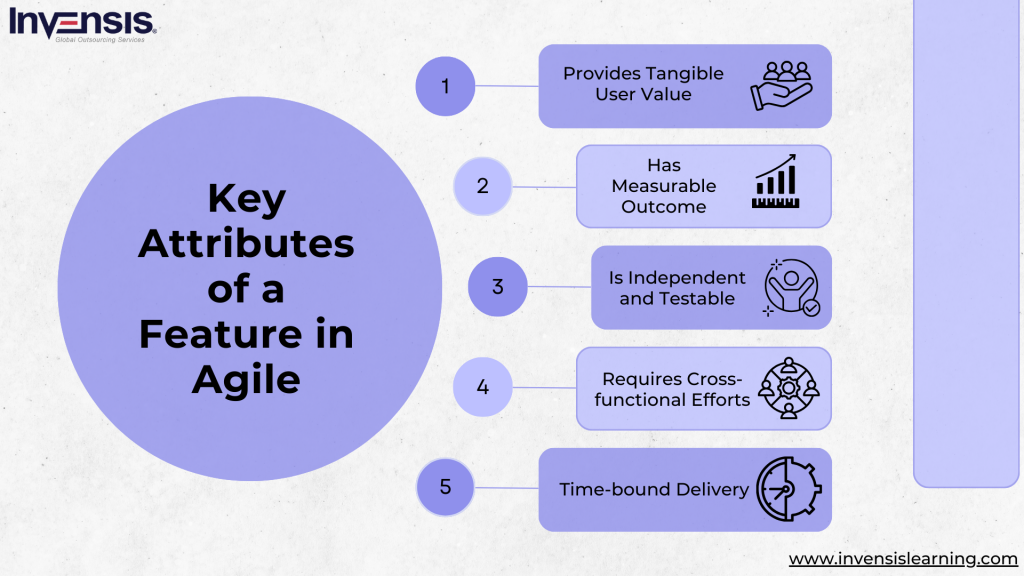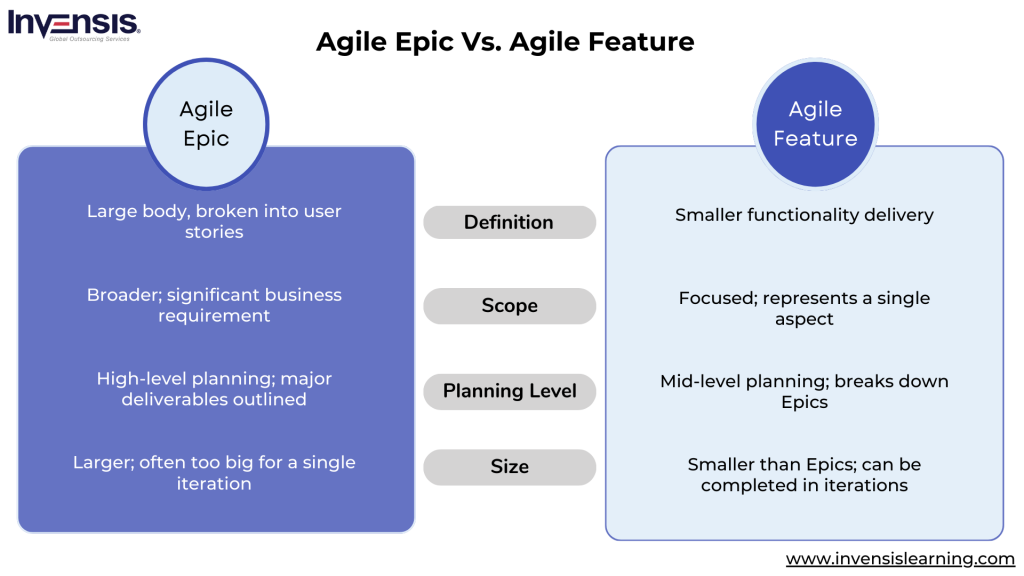
In Agile project management, recognizing the subtleties among various components is essential in development processes to ensure smooth and efficient workflow. Two integral elements in the Agile framework that often spark discussions and debates are “Agile Epics” and “Agile Features.”
As organizations seek to enhance their agility and responsiveness to changing market dynamics, a clear comprehension of these terms becomes paramount.
In this blog, we will take a closer look at the differences between Agile Epics and Features. We’ll talk about what each of them does, how they help in making Agile projects successful, and why it’s important.
Table of Contents:
- What is an Epic in Agile?
- Example of Agile Epic
- What is a Feature in Agile?
- Example of Agile Feature
- Agile Epic vs Feature
- Conclusion
What is an Epic in Agile?
In Agile project management, an Epic is a large and complex work that can be broken down into smaller tasks or stories. It is a way of grouping and organizing work to address a significant piece of functionality, typically too large to be completed in a single iteration or sprint.
Epics help teams plan and manage projects by providing a high-level view of the work that needs to be done, allowing for better coordination and prioritization.
Epics are often defined early in the project planning phase and serve as a roadmap for the development team. As the project progresses, these epics are broken down into smaller, more manageable user stories that can be completed within a shorter time frame.
This hierarchical structure helps Agile teams maintain flexibility and adapt to changing priorities while meeting the overall project goals.
Why are Agile Epics Used?
Epics play a key role in Agile methodology, primarily serving as a strategic tool for project management. These large-scale entities serve several key purposes, from providing an initial high-level overview of significant work or functionalities to aiding teams in comprehending the overall scope of a project.
By defining and prioritizing Epics, teams establish a strategic roadmap, effectively communicating the project’s direction to stakeholders and team members.
Particularly valuable in complex projects, Epics assists in organizing and grouping related tasks, simplifying the management and prioritization of work. Their flexibility allows teams to adapt plans as the project unfolds, breaking down Epics into more manageable user stories.
Furthermore, Epics facilitates prioritization based on value, ensuring critical functionalities are addressed first, aligning with overarching business goals.
As a common language, Epics promotes effective communication among diverse stakeholders, ensuring a shared understanding of project components and objectives. Epic in Agile is a comprehensive tool for planning, organizing, and communicating project goals, empowering teams to navigate complexity, adapt to change, and deliver incremental value.
Example of Agile Epic
Imagine an Agile Epic is focused on upgrading project management software for a medium-sized tech company. The product owner oversees this Epic, ensuring all user stories align with the organization’s objectives. The user stories could include.
- Integration with External Tools
Collaborate with development teams to integrate the project management software with commonly used external tools, such as version control systems and communication platforms
- Enhanced Reporting and Analytics
Implement advanced reporting features to provide project managers with comprehensive analytics on team performance, task completion rates, and project timelines.
- User Interface Overhaul
Redesign the software interface for improved usability and a modern look, incorporating feedback from end-users and stakeholders.
- Customizable Workflow Automation
Introduce a feature that allows teams to customize and automate workflows, streamlining task assignments, approvals, and progress tracking
- Mobile Accessibility
Develop a mobile application to ensure accessibility for users on the go, enabling them to manage projects, track progress, and communicate with team members from their mobile devices.
Enroll in Invensis Learning’s industry-recognized Agile Certification Courses and master Agile Methodology!
What is a Feature in Agile?
In Agile methodology, a Feature is a distinct piece of functionality or capability that delivers value to the end-users. It represents a set of related user stories that, when combined, fulfill a specific business need or requirement.
Features are larger in scope than individual user stories but smaller than epics, providing a mid-level granularity for planning and organizing work within Agile projects.
Key characteristics of features in Agile include:
- User Value: Features are designed to provide tangible value to the end-users or customers. They typically encapsulate a specific functionality or benefit that enhances the product.
- Measurable: Features are often defined in a way that allows for measurement of their success. This could involve metrics related to user satisfaction, system performance, or other relevant key performance indicators (KPIs).
- Independent and Testable: Features should be relatively independent, meaning they can be developed, tested, and deployed without depending heavily on other features. This independence facilitates parallel development and testing.
- Cross-Functional: Features often require collaboration across different functional areas or teams. They combine various skills and expertise to deliver a complete and valuable functionality.
- Time-Bound: While not as large as epics, features are still time-bound. They are developed and delivered within a specified time frame or iteration, allowing continuous improvement and adaptation.
Why is Agile Feature used?
Agile Features are crucial in Agile project management’s iterative and customer-centric approach. These features are used to deliver specific functionalities or capabilities that contribute directly to the value proposition of the end product.
Unlike larger Epics, Features provide a more focused and manageable unit of work, often completed within a single iteration or sprint. This enables Agile teams to respond rapidly to changing requirements, ensuring that tangible and valuable elements are continually delivered to end-users.
Agile Features facilitate a mid-level planning perspective, bridging high-level Epics and user stories. They allow teams to break down complex functionalities into bite-sized, deliverable components, promoting a more efficient and adaptive development process.
By prioritizing and completing Features, Agile teams enhance collaboration and communication and maintain the flexibility needed to navigate evolving project dynamics.
Using Agile Features is a strategic approach to deliver incremental value to end-users while keeping the development process responsive to changing demands.
Example of Agile Feature
The feature involves enhancing the project management tool with a Kanban board to provide users with a visual representation of their project tasks and their progress.
Key elements of this feature could include:
- Board Creation and Customization
Users can create Kanban boards for their projects, with the flexibility to customize columns and labels based on their workflow.
- Drag-and-Drop Task Management
Enable users to move tasks between different stages on the Kanban board using a simple drag-and-drop interface.
- Task Details and Attachments
Allow users to view detailed task information directly from the Kanban board, including attachments, due dates, and assignees.
- Real-Time Collaboration
Implement real-time updates on the Kanban board, ensuring team members see changes instantly, promoting better collaboration.
- Filtering and Sorting Options
Provide users with the ability to filter and sort tasks on the Kanban board based on criteria such as priority, due date, or assignee.
Agile Epic vs Feature
In Agile project management, Epics and Features are terms used to describe different levels of work, each serving a specific purpose in organizing and managing projects. Here’s a breakdown of Agile Epic vs. Feature.
| Aspect | Agile Epic | Agile Feature |
| Definition | A substantial, comprehensive body of work, often divided into user stories, addressing major functionalities. | A specific, smaller piece of functionality delivering direct value to end-users within the broader project. |
| Scope | Broader, addressing significant business requirements or extensive functionalities crucial for project success. | More focused, representing a distinct and targeted functional aspect of the overall product or system. |
| Planning Level | High-level planning, outlining major deliverables and providing a strategic roadmap for the entire project. | Mid-level planning, focusing on breaking down Epics into manageable components for detailed execution. |
| Size | Larger, often too extensive to be completed within a single iteration or sprint, requiring phased development. | Smaller than Epics but larger than individual user stories, allowing for completion within a specific iteration or a few iterations. |
Also, read the Agile epic vs user story blog to understand the differences with an example!
Agile Epic
An Agile Epic is a comprehensive unit of work within the Agile project management framework. Defined as a substantial body of work that can be further broken down into more manageable pieces, known as user stories, Epics have a broad scope, often encapsulating significant business requirements or substantial functionalities.
These high-level entities play a crucial role in the initial stages of project planning, helping outline significant deliverables in the project roadmap. Due to their size and complexity, Epics are typically too large to be completed within a single iteration or sprint.
For instance, in a software development project, an Epic could revolve around tasks like “Implement User Authentication System” or “Overhaul Payment Processing.”
Agile Feature
In the Agile context, a Feature serves as a more focused and specific unit of functionality that delivers value to end-users. Smaller in scope than Epics but larger than individual user stories, Features are integral to mid-level planning.
They break down the broader Epics into more manageable components, allowing for a more detailed and targeted approach to project management.
Features can often be completed within one or a few iterations, providing a tangible and deliverable aspect of the overall project. For example, in a project management tool, a Feature could be something like “Kanban Board Integration” or “Enhanced Task Filtering,” each contributing to the incremental value of the product or system.
Conclusion
The distinction between Agile Epics and Features is a key aspect of effective project management within the Agile framework.
The synergy between Epics and Features provides Agile teams with a powerful framework for prioritization, adaptability, and the incremental delivery of value to end-users. Recognizing the unique roles of Epics and Features not only streamlines the planning process but also enhances the overall agility and responsiveness of development teams.
By understanding these distinctions, Agile practitioners, whether seasoned or newcomers, can navigate the complexities of project management with greater precision, ultimately contributing to the success of their Agile endeavors.
Embark on an Agile learning journey at Invensis and unlock the distinctions between Agile Epics and Features. Our Agile courses provide the key to success in dynamic project management, facilitating innovation, teamwork, and customer satisfaction.
















